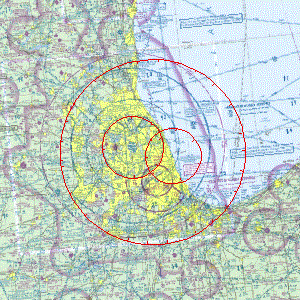Wed, Jul 22, 2009
Pilots Traveling To Oshkosh Thursday And Friday Could Be
Affected
 A TFR has been issued
for Thursday and Friday around the greater Chicago area
corresponding with a visit by President Obama to the region, and
pilots wishing to transit the area on their way to Oshkosh will
need to plan accordingly.
A TFR has been issued
for Thursday and Friday around the greater Chicago area
corresponding with a visit by President Obama to the region, and
pilots wishing to transit the area on their way to Oshkosh will
need to plan accordingly.
The largest of the areas covered by the TFR, designated 'Area A'
is centered on the Northbrook VOR/DME (OBK) 155 degree radial at
18.5 nautical miles. (Latitude: 41º56'41"N, Longitude:
87º46'00"W). It extends for 30 nautical miles and covers
altitudes up to, but not including 18,000 feet MSL. The TFR is in
effect from July 23, 2009 at 2100 UTC (July 23, 2009 at 1600 CDT)
to July 24, 2009 at 0200 UTC (July 23, 2009 at 2100 CDT).
There are three other smaller areas designated by the TFR at
more specfic times.
According to the FAA, no pilots may operate an aircraft in the
areas covered by this NOTAM (except as described). Except as
specified below and/or unless authorized by ATC in consultation
with the air traffic security coordinator via the domestic events
network (DEN):
- A. All aircraft operations within the 10 NMR area(s) listed
above, known as the inner core(s), are prohibited except for:
Approved law enforcement, military aircraft directly supporting the
United States Secret Service (USSS) and the office of the President
of the United States, approved air ambulance flights, and regularly
scheduled commercial passenger and all-cargo carriers operating
under one of the following TSA-Approved standard security
programs/procedures: aircraft operator standard security program
(AOSSP), full all-cargo aircraft operator standard security program
(FACAOSSP), model security program (MSP), twelve five standard
security program (TFSSP) all cargo, or all-cargo international
security procedure (ACISP) and are arriving into and/or departing
from 14 cfr part 139 airports. All emergency/life saving flight
(medical/law enforcement/firefighting) operations must coordinate
with ATC prior to their departure at 847-608-5911 to avoid
potential delays.
- B. For operations within the airspace between the 10 nmr and 30
nmr area(s) listed above, known as the outer ring(s): All aircraft
operating within the outer ring(s) listed above are limited to
aircraft arriving or departing local airfields, and workload
permitting, ATC may authorize transit operations. Aircraft may not
loiter. All aircraft must be on an active IFR or VFR flight plan
with a discrete code assigned by an air traffic control (ATC)
facility. Aircraft must be squawking the discrete code prior to
departure and at all times while in the TFR and must remain in
two-way radio communications with ATC.
- C. The following operations are not authorized within this TFR:
flight training, practice instrument approaches, aerobatic flight,
glider operations, parachute operations, ultralight, hang gliding,
balloon operations, agriculture/crop dusting, animal population
control flight operations, banner towing operations, model aircraft
operations, model rocketry, and unmanned aircraft systems
(UAS).
- D. FAA recommends that all aircraft operators check NOTAMs
frequently for possible changes to this TFR prior to operations
within this region.

The FAA additionally recommends that pilots planning to transit
the area during the TFR should contact your local FSS for complete
information for flight planning purposes.
More News
Option Approach An approach requested and conducted by a pilot which will result in either a touch-and-go, missed approach, low approach, stop-and-go, or full stop landing. Pilots >[...]
"Emirates is already the world's largest Boeing 777 operator, and we are expanding our commitment to the program today with additional orders for 65 Boeing 777-9s. This is a long-t>[...]
(Pilot) Reported That There Was A Sudden And Violent Vibration Throughout The Airplane That Lasted Several Seconds Analysis: The pilot was returning to his home airport at an altit>[...]
“This recognition was evident during the TBMOPA Annual Convention, where owners and operators clearly expressed their satisfaction with our focus on customer service, and enc>[...]
Overhead Maneuver A series of predetermined maneuvers prescribed for aircraft (often in formation) for entry into the visual flight rules (VFR) traffic pattern and to proceed to a >[...]
 ANN's Daily Aero-Term (11.19.25): Option Approach
ANN's Daily Aero-Term (11.19.25): Option Approach Aero-News: Quote of the Day (11.19.25)
Aero-News: Quote of the Day (11.19.25) NTSB Final Report: Sting Sport TL-2000
NTSB Final Report: Sting Sport TL-2000 Aero-News: Quote of the Day (11.20.25)
Aero-News: Quote of the Day (11.20.25) ANN's Daily Aero-Term (11.20.25): Overhead Maneuver
ANN's Daily Aero-Term (11.20.25): Overhead Maneuver




